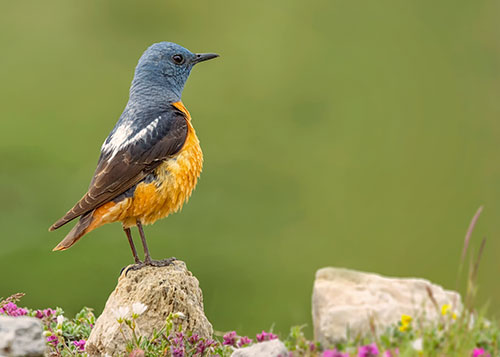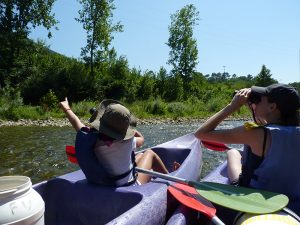Welcome to the exciting and colourful life of the common rock thrush, a winged artist who paints and colours the landscapes in spring and summer. Join us to learn a little about the life of this winged painter.
Common rock thrush in shorts
Scientific name: Monticola saxatilis.
*Nickname: Mountain painter.
*Distribution: Europe, Asia and Africa.
*State of conservation in Spain: near threatened, according to the book Libro Rojo de las Aves de España 2021 (Red book of birds in Spain, 2021)

Profile of a winged artist
Plumage and dazzling colours
The common rock thrus is a mixture of colours, with a striking plumage, combining shades of orange, blue and grey. Particularly, the males exhibit a distinctive red breast during the breeding season. They can stand out on the Picos de Europa stones and rocks, although this colour can sometimes be confused with the lichens on the limestone rock.
Mountain habitat
It is a typical mountain bird, which likes heights. It inhabits places with alternating rocky areas, scrubland and grassland close to rocks and cliffs. Places with little presence of trees, looking for open places.
Assorted diet and expert hunting
The diet of a common rock thrush is based on insects and small invertebrates. It is a skillful hunter that can hunt prey in flight with considerable agility. Beetles, caterpillars and grasshoppers are part of its usual diet. They hunt several preys before returning to the nest, make the most of each ride.
Melodic singing
When the breeding season arrives, during the rut, males display their musical talent with melodic songs to attract females. You can listen to their song here.

Hidden nests
Common rock thrushes are masters at the art of concealing their nests, hiding them in rock cracks, rock walls or even on rooftops, so that they are hidden from predators. When nesting in alpine areas they lay one clutch, but when nesting in subalpine areas they may lay two clutches per year. They usually incubate the eggs for two weeks and spend two more weeks until the chicks can fly from the nest.
Amazing facts
Intriguing migration
Great travellers, they arrive from Africa in spring to breed and spend the summer, and in autumn they return to their wintering grounds, travelling long distances twice a year.
Acrobatic flight
Even though it can be seen perched on rocks for a while, it is also pretty graceful in flight, manoeuvring between rock formations with great agility. A very enjoyable bird to watch, both when perched and in flight.
All in all, the red rock thrush not only paints our mountains, but also makes them sound with its song during spring and summer. You can read more about this wonderful bird and, if you are interested in seeing it in Picos de Europa, you can contact us. Don’t miss it!



